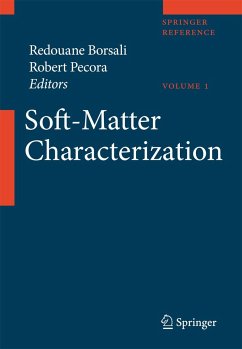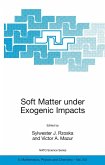Soft-Matter Characterization
Herausgeber: Borsali, Redouane; Pecora, Robert
Schade – dieser Artikel ist leider ausverkauft. Sobald wir wissen, ob und wann der Artikel wieder verfügbar ist, informieren wir Sie an dieser Stelle.
Soft-Matter Characterization
Herausgeber: Borsali, Redouane; Pecora, Robert
- Broschiertes Buch
- Merkliste
- Auf die Merkliste
- Bewerten Bewerten
- Teilen
- Produkt teilen
- Produkterinnerung
- Produkterinnerung
This 2-volume set includes extensive discussions of scattering techniques (light, neutron and X-ray) and related fluctuation and grating techniques that are at the forefront of this field. Most of the scattering techniques are Fourier space techniques. Recent advances have seen the development of powerful direct imaging methods such as atomic force microscopy and scanning probe microscopy. In addition, techniques that can be used to manipulate soft matter on the nanometer scale are also in rapid development. These include the scanning probe microscopy technique mentioned above as well as optical and magnetic tweezers.…mehr
Andere Kunden interessierten sich auch für
![Soft-Matter Characterization Soft-Matter Characterization]() Redouane Borsali / Robert Pecora (eds.)Soft-Matter Characterization403,99 €
Redouane Borsali / Robert Pecora (eds.)Soft-Matter Characterization403,99 €![Ionic Soft Matter: Modern Trends in Theory and Applications Ionic Soft Matter: Modern Trends in Theory and Applications]() Douglas Henderson / Myroslav Holovko / Andrij Trokhymchuk (eds.)Ionic Soft Matter: Modern Trends in Theory and Applications82,99 €
Douglas Henderson / Myroslav Holovko / Andrij Trokhymchuk (eds.)Ionic Soft Matter: Modern Trends in Theory and Applications82,99 €![P.G. de Gennes' Impact on Science - Volume II: Soft Matter and Biophysics P.G. de Gennes' Impact on Science - Volume II: Soft Matter and Biophysics]() P.G. de Gennes' Impact on Science - Volume II: Soft Matter and Biophysics69,99 €
P.G. de Gennes' Impact on Science - Volume II: Soft Matter and Biophysics69,99 €![Ionic Soft Matter: Modern Trends in Theory and Applications Ionic Soft Matter: Modern Trends in Theory and Applications]() Douglas Henderson / Myroslav Holovko / Andrij Trokhymchuk (eds.)Ionic Soft Matter: Modern Trends in Theory and Applications121,99 €
Douglas Henderson / Myroslav Holovko / Andrij Trokhymchuk (eds.)Ionic Soft Matter: Modern Trends in Theory and Applications121,99 €![Soft Matter Under Exogenic Impacts Soft Matter Under Exogenic Impacts]() Sylwester J. Rzoska / Victor A. Mazur (eds.)Soft Matter Under Exogenic Impacts186,99 €
Sylwester J. Rzoska / Victor A. Mazur (eds.)Soft Matter Under Exogenic Impacts186,99 €![Soft Matter under Exogenic Impacts Soft Matter under Exogenic Impacts]() Sylwester J. Rzoska / Victor A. Mazur (eds.)Soft Matter under Exogenic Impacts112,99 €
Sylwester J. Rzoska / Victor A. Mazur (eds.)Soft Matter under Exogenic Impacts112,99 €![Time-Resolved Spectroscopy in Complex Liquids Time-Resolved Spectroscopy in Complex Liquids]() Time-Resolved Spectroscopy in Complex Liquids112,99 €
Time-Resolved Spectroscopy in Complex Liquids112,99 €-
-
-
This 2-volume set includes extensive discussions of scattering techniques (light, neutron and X-ray) and related fluctuation and grating techniques that are at the forefront of this field. Most of the scattering techniques are Fourier space techniques. Recent advances have seen the development of powerful direct imaging methods such as atomic force microscopy and scanning probe microscopy. In addition, techniques that can be used to manipulate soft matter on the nanometer scale are also in rapid development. These include the scanning probe microscopy technique mentioned above as well as optical and magnetic tweezers.
Produktdetails
- Produktdetails
- Verlag: Springer / Springer Netherland
- 2008 edition
- Seitenzahl: 1452
- Erscheinungstermin: 4. Dezember 2008
- Englisch
- ISBN-13: 9781402082900
- ISBN-10: 1402082908
- Artikelnr.: 25942536
- Herstellerkennzeichnung
- Libri GmbH
- Europaallee 1
- 36244 Bad Hersfeld
- gpsr@libri.de
- Verlag: Springer / Springer Netherland
- 2008 edition
- Seitenzahl: 1452
- Erscheinungstermin: 4. Dezember 2008
- Englisch
- ISBN-13: 9781402082900
- ISBN-10: 1402082908
- Artikelnr.: 25942536
- Herstellerkennzeichnung
- Libri GmbH
- Europaallee 1
- 36244 Bad Hersfeld
- gpsr@libri.de
Redouane Borsali is Director of Research at the LCPO, a Polymer Research CNRS Laboratory, associated with the University of Bordeaux, France. He studied Physics at the University of Tlemcen, Algeria and received his Masters and Ph.D. in Polymer Physics at the Institute Charles Sadron (Louis Pasteur University, Strasbourg, France) in 1988. After his postdoctoral research position at the Max-Planck-Institute for Polymer Research (MPI-P) at Mainz, Germany in 1990 he joined the CNRS (Grenoble, France). In 1995, he spent a sabbatical leave at Stanford University and at IBM Almaden Research Center, CA, USA as a visiting scientist. He joined the LCPO in 2000 as the Polymer Physical-Chemistry Group Leader. His main research activities are focused on the study of the Structure, Dynamics and Self-assemblies of "Soft Matter" and particularly on Controlled Architecture Polymers such as block copolymers, polymer mixtures, polyelectrolytes, micelles, vesicles and rod-like particles. He is the author or co-author of over 110 research articles and two books. Robert Pecora is Professor of Chemistry at Stanford University, USA. He received his A.B., A.M. and Ph.D. degrees from Columbia University, USA. After postdoctoral work at the Universite Libre de Bruxelles, Belgium and Columbia University he joined the Stanford University faculty in 1964. His research interests are in the areas of condensed phase dynamics of small molecules, macromolecules and colloids of both materials and biological interest. He is one of the major developers of the dynamic light scattering technique and has used many of the other techniques described in these volumes. His research emphasis is now on liquids near the glass transition, rigid rod polymers, polyelectrolytes and composite liquids. He is the author or co-author of over 130 research articles and five books.
VOLUME I
1. Basic Concepts - Scattering and Time Correlation Functions (R. Pecora)
2. Total Intensity Light Scattering from Solutions Macromolecules (G.C.
Berry) 3. Disordered Phase and Self-Organization of Block Copolymer Systems
(C. Giacomelli and R. Borsali) 4. Small-Angle Scattering from Surfactants
and Block Copolymer Micelles (J.S. Pedersen) 5. Brush-Like Polymers (Y.
Nakamaru and T. Norisuye) 6. Polyelectrolytes-Theory and Simulations (C.
Holm) 7. Dynamic Light Scattering (B. Chu) 8. Light Scattering from
Multicomponent Polymer Systems in Shear Fields: Real-time, In Situ Studies
of Dissipative Structures in Open Nonequilibrium Systems (T. Hashimoto) 9.
Light Scattering from Polysaccharides as Soft Material (W. Burchard) 10.
Fluorescence Photobleaching Recovery (P.S. Russo, J. Qiu, N. Edwin, Y.W.
Choi, G. J. Doucet, and D. Sohn) 11. Fluorescence Correlation Spectroscopy
(E. Haustein and P. Schwille) 12. Forced Rayleigh Scattering - Principles
and Application (Self Diffusion of Spherical Nanoparticles and Copolymer
Micelles) (W. Schärtl)
VOLUME II
13. Small-Angle Neutron Scattering and Applications in Soft Condensed
Matter (I. Grillo) 14. Small Angle Neutron Scattering on Gels (M. Shibayama
) 15. Complex Melts under Extreme Conditions: From Liquid Crystal to
Polymers (L. Noirez) 16. In Situ Investigation of Adsorbed Amphiphilic
Block Copolymers by Ellipsometry and Neutron Reflectometry (R. Toomey and
M. Tirrell) 17. Synchroton Small-Angle X-Ray Scattering (T. Narayanan) 18.
X-Ray Photon Correlation Spectroscopy (XPCS) (G. Grübel, A. Madsen, and A.
Robert) 19. Analysis of Polyelectrolytes by Small-Angle X-Ray Scattering (
M. Ballauff) 20. Small-Angle Scattering of Block Copolymers (I. Hamley and
V. Castelletto) 21. Structural Studies of Proteins and Nucleic Acids in
Solution Using Small-Angle X-Ray Scattering (SAXS) (R. Das and S. Doniach)
22. Transmission Electron Microscopy Imaging of Block Copolymer Aggregates
in Solutions (N. Duxin and A. Eisenberg) 23. Single-Molecule Studies of DNA
(J.P. Rickgauer and D.E. Smith) 24. Single Molecule Microscopy (Y. Ishii,
J. Kozuka, S. Esaki and T. Yanagida) 25. Visualising Properties of Polymers
at Interfaces (G. Reiter) 26. Optical Microscopy of Fluctuating Giant
Vesicles and Motile Cells (H.G. Döbereiner) 27. Highly-Branched
Polymers: From Comb to Dendritic Architectures (P. Viville, M. Schappacher,
R. Lazarroni, and A. Deffieux) 28. AFM Imaging in Physiological
Environment: From Biomolecules to Living Cells (T. Cohen-Bouhacina and A.
Maali)
1. Basic Concepts - Scattering and Time Correlation Functions (R. Pecora)
2. Total Intensity Light Scattering from Solutions Macromolecules (G.C.
Berry) 3. Disordered Phase and Self-Organization of Block Copolymer Systems
(C. Giacomelli and R. Borsali) 4. Small-Angle Scattering from Surfactants
and Block Copolymer Micelles (J.S. Pedersen) 5. Brush-Like Polymers (Y.
Nakamaru and T. Norisuye) 6. Polyelectrolytes-Theory and Simulations (C.
Holm) 7. Dynamic Light Scattering (B. Chu) 8. Light Scattering from
Multicomponent Polymer Systems in Shear Fields: Real-time, In Situ Studies
of Dissipative Structures in Open Nonequilibrium Systems (T. Hashimoto) 9.
Light Scattering from Polysaccharides as Soft Material (W. Burchard) 10.
Fluorescence Photobleaching Recovery (P.S. Russo, J. Qiu, N. Edwin, Y.W.
Choi, G. J. Doucet, and D. Sohn) 11. Fluorescence Correlation Spectroscopy
(E. Haustein and P. Schwille) 12. Forced Rayleigh Scattering - Principles
and Application (Self Diffusion of Spherical Nanoparticles and Copolymer
Micelles) (W. Schärtl)
VOLUME II
13. Small-Angle Neutron Scattering and Applications in Soft Condensed
Matter (I. Grillo) 14. Small Angle Neutron Scattering on Gels (M. Shibayama
) 15. Complex Melts under Extreme Conditions: From Liquid Crystal to
Polymers (L. Noirez) 16. In Situ Investigation of Adsorbed Amphiphilic
Block Copolymers by Ellipsometry and Neutron Reflectometry (R. Toomey and
M. Tirrell) 17. Synchroton Small-Angle X-Ray Scattering (T. Narayanan) 18.
X-Ray Photon Correlation Spectroscopy (XPCS) (G. Grübel, A. Madsen, and A.
Robert) 19. Analysis of Polyelectrolytes by Small-Angle X-Ray Scattering (
M. Ballauff) 20. Small-Angle Scattering of Block Copolymers (I. Hamley and
V. Castelletto) 21. Structural Studies of Proteins and Nucleic Acids in
Solution Using Small-Angle X-Ray Scattering (SAXS) (R. Das and S. Doniach)
22. Transmission Electron Microscopy Imaging of Block Copolymer Aggregates
in Solutions (N. Duxin and A. Eisenberg) 23. Single-Molecule Studies of DNA
(J.P. Rickgauer and D.E. Smith) 24. Single Molecule Microscopy (Y. Ishii,
J. Kozuka, S. Esaki and T. Yanagida) 25. Visualising Properties of Polymers
at Interfaces (G. Reiter) 26. Optical Microscopy of Fluctuating Giant
Vesicles and Motile Cells (H.G. Döbereiner) 27. Highly-Branched
Polymers: From Comb to Dendritic Architectures (P. Viville, M. Schappacher,
R. Lazarroni, and A. Deffieux) 28. AFM Imaging in Physiological
Environment: From Biomolecules to Living Cells (T. Cohen-Bouhacina and A.
Maali)
VOLUME I
1. Basic Concepts - Scattering and Time Correlation Functions (R. Pecora)
2. Total Intensity Light Scattering from Solutions Macromolecules (G.C.
Berry) 3. Disordered Phase and Self-Organization of Block Copolymer Systems
(C. Giacomelli and R. Borsali) 4. Small-Angle Scattering from Surfactants
and Block Copolymer Micelles (J.S. Pedersen) 5. Brush-Like Polymers (Y.
Nakamaru and T. Norisuye) 6. Polyelectrolytes-Theory and Simulations (C.
Holm) 7. Dynamic Light Scattering (B. Chu) 8. Light Scattering from
Multicomponent Polymer Systems in Shear Fields: Real-time, In Situ Studies
of Dissipative Structures in Open Nonequilibrium Systems (T. Hashimoto) 9.
Light Scattering from Polysaccharides as Soft Material (W. Burchard) 10.
Fluorescence Photobleaching Recovery (P.S. Russo, J. Qiu, N. Edwin, Y.W.
Choi, G. J. Doucet, and D. Sohn) 11. Fluorescence Correlation Spectroscopy
(E. Haustein and P. Schwille) 12. Forced Rayleigh Scattering - Principles
and Application (Self Diffusion of Spherical Nanoparticles and Copolymer
Micelles) (W. Schärtl)
VOLUME II
13. Small-Angle Neutron Scattering and Applications in Soft Condensed
Matter (I. Grillo) 14. Small Angle Neutron Scattering on Gels (M. Shibayama
) 15. Complex Melts under Extreme Conditions: From Liquid Crystal to
Polymers (L. Noirez) 16. In Situ Investigation of Adsorbed Amphiphilic
Block Copolymers by Ellipsometry and Neutron Reflectometry (R. Toomey and
M. Tirrell) 17. Synchroton Small-Angle X-Ray Scattering (T. Narayanan) 18.
X-Ray Photon Correlation Spectroscopy (XPCS) (G. Grübel, A. Madsen, and A.
Robert) 19. Analysis of Polyelectrolytes by Small-Angle X-Ray Scattering (
M. Ballauff) 20. Small-Angle Scattering of Block Copolymers (I. Hamley and
V. Castelletto) 21. Structural Studies of Proteins and Nucleic Acids in
Solution Using Small-Angle X-Ray Scattering (SAXS) (R. Das and S. Doniach)
22. Transmission Electron Microscopy Imaging of Block Copolymer Aggregates
in Solutions (N. Duxin and A. Eisenberg) 23. Single-Molecule Studies of DNA
(J.P. Rickgauer and D.E. Smith) 24. Single Molecule Microscopy (Y. Ishii,
J. Kozuka, S. Esaki and T. Yanagida) 25. Visualising Properties of Polymers
at Interfaces (G. Reiter) 26. Optical Microscopy of Fluctuating Giant
Vesicles and Motile Cells (H.G. Döbereiner) 27. Highly-Branched
Polymers: From Comb to Dendritic Architectures (P. Viville, M. Schappacher,
R. Lazarroni, and A. Deffieux) 28. AFM Imaging in Physiological
Environment: From Biomolecules to Living Cells (T. Cohen-Bouhacina and A.
Maali)
1. Basic Concepts - Scattering and Time Correlation Functions (R. Pecora)
2. Total Intensity Light Scattering from Solutions Macromolecules (G.C.
Berry) 3. Disordered Phase and Self-Organization of Block Copolymer Systems
(C. Giacomelli and R. Borsali) 4. Small-Angle Scattering from Surfactants
and Block Copolymer Micelles (J.S. Pedersen) 5. Brush-Like Polymers (Y.
Nakamaru and T. Norisuye) 6. Polyelectrolytes-Theory and Simulations (C.
Holm) 7. Dynamic Light Scattering (B. Chu) 8. Light Scattering from
Multicomponent Polymer Systems in Shear Fields: Real-time, In Situ Studies
of Dissipative Structures in Open Nonequilibrium Systems (T. Hashimoto) 9.
Light Scattering from Polysaccharides as Soft Material (W. Burchard) 10.
Fluorescence Photobleaching Recovery (P.S. Russo, J. Qiu, N. Edwin, Y.W.
Choi, G. J. Doucet, and D. Sohn) 11. Fluorescence Correlation Spectroscopy
(E. Haustein and P. Schwille) 12. Forced Rayleigh Scattering - Principles
and Application (Self Diffusion of Spherical Nanoparticles and Copolymer
Micelles) (W. Schärtl)
VOLUME II
13. Small-Angle Neutron Scattering and Applications in Soft Condensed
Matter (I. Grillo) 14. Small Angle Neutron Scattering on Gels (M. Shibayama
) 15. Complex Melts under Extreme Conditions: From Liquid Crystal to
Polymers (L. Noirez) 16. In Situ Investigation of Adsorbed Amphiphilic
Block Copolymers by Ellipsometry and Neutron Reflectometry (R. Toomey and
M. Tirrell) 17. Synchroton Small-Angle X-Ray Scattering (T. Narayanan) 18.
X-Ray Photon Correlation Spectroscopy (XPCS) (G. Grübel, A. Madsen, and A.
Robert) 19. Analysis of Polyelectrolytes by Small-Angle X-Ray Scattering (
M. Ballauff) 20. Small-Angle Scattering of Block Copolymers (I. Hamley and
V. Castelletto) 21. Structural Studies of Proteins and Nucleic Acids in
Solution Using Small-Angle X-Ray Scattering (SAXS) (R. Das and S. Doniach)
22. Transmission Electron Microscopy Imaging of Block Copolymer Aggregates
in Solutions (N. Duxin and A. Eisenberg) 23. Single-Molecule Studies of DNA
(J.P. Rickgauer and D.E. Smith) 24. Single Molecule Microscopy (Y. Ishii,
J. Kozuka, S. Esaki and T. Yanagida) 25. Visualising Properties of Polymers
at Interfaces (G. Reiter) 26. Optical Microscopy of Fluctuating Giant
Vesicles and Motile Cells (H.G. Döbereiner) 27. Highly-Branched
Polymers: From Comb to Dendritic Architectures (P. Viville, M. Schappacher,
R. Lazarroni, and A. Deffieux) 28. AFM Imaging in Physiological
Environment: From Biomolecules to Living Cells (T. Cohen-Bouhacina and A.
Maali)








